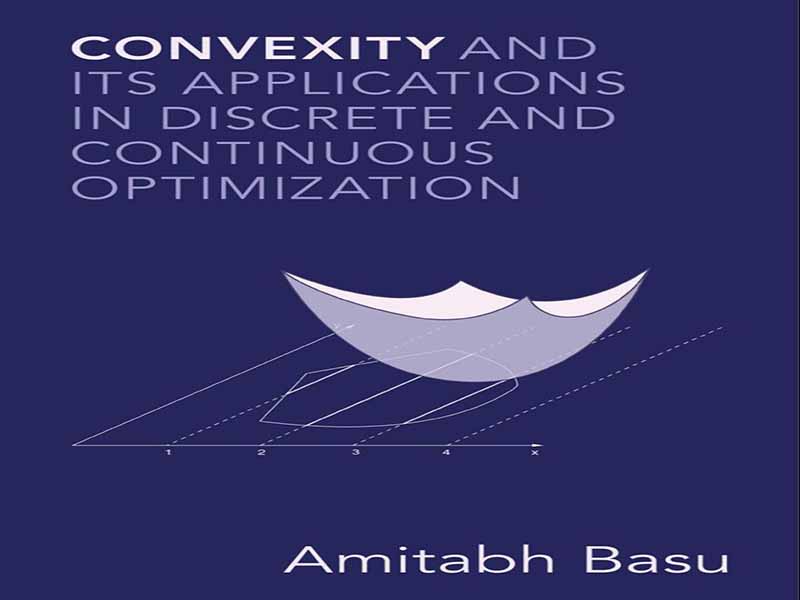- عنوان کتاب: Convexity and its Applications in Discrete and Continuous Optimization
- نویسنده: AMITABH BASU
- حوزه: ریاضیات کاربردی
- سال انتشار: 2025
- تعداد صفحه: 329
- زبان اصلی: انگلیسی
- نوع فایل: pdf
- حجم فایل: 2.72 مگابایت
این کتاب در مورد تجزیه و تحلیل محدب و هندسه و همچنین استفاده از آنها در بهینه سازی ریاضی است. بهینهسازی ریاضی تقریباً در تمام رشتههای ریاضی و محاسباتی نقش محوری دارد و نمیتوان بر اهمیت آن در عصر علم داده، یادگیری ماشین و هوش مصنوعی بیش از حد تأکید کرد. تقریباً هر مسئله ای در این زمینه ها یک مسئله بهینه سازی ریاضی در هسته خود دارد. این کتاب در درجه اول بر بهینه سازی محدب (هم گسسته و هم پیوسته) و مبانی ریاضی آن تمرکز دارد. دسترسی به روش های بهینه سازی محدب و به طور کلی، مفاهیم زیربنایی از تجزیه و تحلیل محدب و هندسه در تجارت، مهندسی و کاربردهای علمی نیز قابل توجه است. ایده ساده پشت تحدب – که «مقدار» میانگین راهحلهای بالقوه چندگانه حداقل به اندازه «مقدار» متوسط این راهحلها خوب است – توانایی مدلسازی انواع شگفتانگیز از پدیدهها را دارد. کتابهای درسی کافی در مورد محدب و بهینهسازی محدب وجود دارد که میتواند کل بخش یک کتابخانه دانشگاهی (مجازی) را اشغال کند. دو دلیل وجود دارد که چرا من معتقدم این کتاب چیز جدید و ارزشمندی را ارائه می دهد، به ویژه از منظر طراحی دوره ای که این ایده ها را به طور دقیق معرفی می کند. اولاً، من احساس میکنم که کتابهای درسی و تکنگاریهای قبلی یا بر جنبههای مستمر/تحلیلی تحدب تمرکز دارند 124، 128، 234]، و هیچ کتاب واحدی ایدههای اصلی را در هر دو جنبه (نظریه و کاربردها در بهینهسازی) به صورت یکپارچه بررسی نمیکند. این پیشرفتها اکنون به سطحی از بلوغ رسیدهاند که میتوان آن را در یک کتاب درسی ارائه کرد، با شواهد تمیز و ظریفی که برای نتایج اصلی در دسترس است. من متقاعد شدهام که زمان مناسبی برای کتاب درسی است که چشمانداز واحدی در مورد بهینهسازی پیوسته و گسسته از طریق دریچه محدب ارائه میدهد، و برخی از پیشرفتهای اخیر در بهینهسازی را ارائه میدهد که هنوز به متون مربوط به تحدب نرسیده است. کتاب به دو بخش تقسیم شده است. بخش اول بر مبانی ریاضی تجزیه و تحلیل محدب و هندسه متمرکز است، که با مطالعه مجموعههای محدب شروع میشود، سپس به توضیح توابع محدب میپردازد و با مقدمهای بر هندسه اعداد پایان مییابد. بخش دوم بر بهینه سازی، ارائه ایده های گسسته و پیوسته در یک چارچوب مشترک تمرکز دارد. در اینجا برخی از موضوعات مطرح شده در این کتاب درسی وجود دارد که تا آنجا که من می دانم، در هیچ کتاب درسی قبلی در مورد تجزیه و تحلیل محدب، هندسه یا بهینه سازی وجود ندارد.
This book is about convex analysis and geometry, as well as their use in mathematical optimization. Mathematical optimization plays a central role in almost all mathematical and computational disciplines, and its importance in the age of data science, machine learning, and artificial intelligence cannot be overemphasized. Almost every problem in these areas has a mathematical optimization problem at its core. This book focuses primarily on convex optimization (both discrete and continuous) and its mathematical foundations. The reach of convex optimization methods and, more generally, the underlying concepts from convex analysis and geometry in business, engineering, and scientific applications is also significant. The simple idea behind convexity – that the “value” of an average of multiple potential solutions is at least as good as the average “value” of these solutions – has the ability to model an amazing variety of phenomena. There are enough textbooks on convexity and convex optimization to occupy an entire section of an academic (virtual) library. There are two reasons why I believe this book provides something new and valuable, particularly from the perspective of designing a course that introduces these ideas rigorously. First, I feel that previous textbooks and monographs focus either on the continuous/analytic aspects of convexity [42, 44, 45, 57, 59, 114, 131, 140, 141, 170, 183, 199, 210, 220] or on the discrete/combinatorial aspects of convexity [24, 116, 124, 128, 234], and no one single book surveys in a unified way the main ideas in both of these aspects (theory and applications in optimization).1 Second, there have been several recent developments, especially in the use of convexity in discrete optimization, that appear only in specialized research papers or surveys. These developments have now reached a level of maturity that can be presented in a textbook, with clean and elegant proofs available for the major results. I am convinced that the time is right for a textbook that gives a unified perspective on continuous and discrete optimization via the lens of convexity, and presents some of the recent advances in optimization that have not yet made it to the texts on convexity. The book is divided into two parts. The first part focuses on the mathematical foundations of convex analysis and geometry, starting with a study of convex sets, followed by an exposition of convex functions, and ending with an introduction to the geometry of numbers. The second part focuses on optimization, presenting discrete and continuous ideas in a common framework. Here are some topics covered in this textbook that, to the best of my knowledge, are not contained in any previous textbook on convex analysis, geometry, or optimization.
این کتاب را میتوانید از لینک زیر بصورت رایگان دانلود کنید:
Download: Convexity and its Applications in Discrete and Continuous Optimization




































نظرات کاربران